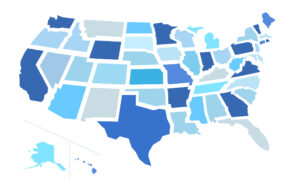
COLUMBUS, Ohio (BP) — Ohioans codified abortion rights and legalized marijuana for adults Nov. 7, all in a state with a Republican governor and Republican legislative supermajority.
Ohioans passed Issue 1 by 56.62 percent of the vote, codifying abortion and reproductive rights in the state’s constitution, and overriding a six-week abortion ban the courts had blocked. The law allows abortion until fetal viability or later to protect the life and health of the mother.
Fetal viability is seen around six months of pregnancy and is also determined by the health of the fetus. Issue 1 leaves the determination with the mother’s physician.
Issue 2, legalizing and taxing the recreational use and production of marijuana for adults 21 and over, passed by 56.97 percent of the vote, according to unofficial results from Ohio Secretary of State Frank LaRose. Both laws are effective 30 days after passage.
Ethics & Religious Liberty Commission (ERLC) President Brent Leatherwood, citing the decades of work that led to the reversal of Roe v. Wade, said the Ohio results reinforce the need for continued advocacy.
“It does offer a new opportunity for us to proclaim the pro-family vision we have, one that renders abortion unthinkable,” Leatherwood told Baptist Press.
“Just today, in the aftermath of these results as I had meetings on Capitol Hill in Washington, earnest discussions are taking place with our nation’s lawmakers to enhance pathways for adoption and family formation through legislation.
“As we at the ERLC help policymakers shape these proposals, it is imperative for all of us who care about the lives of preborn children, their mothers and families to make it clear that abortion is wrong and the ability to end a defenseless life is no freedom at all.”
Some legislators in the state with 66 Republican and 32 Democratic lawmakers pledged after the vote to pass legislation restricting the newly approved measures. Doing so would be easier for Issue 2, an initiated statute, than for Issue 1, a constitutional amendment.
“The legislature has multiple paths that we will explore to continue to protect innocent life,” The Columbus Dispatch quoted House Speaker Jason Stephens on Nov. 8.
Senate President Mike Huffman also committed to protecting life in comments to the Dispatch.
“Life is worth fighting for. As a grandparent of eight, the life of a baby is always worth the fight,” Huffman said. “The national abortion industry funded by wealthy out-of-state special interests spent millions to pass this radical language that goes far past abortion on demand. This isn’t the end. It is really just the beginning of a revolving door of ballot campaigns to repeal or replace Issue 1.”
Gov. Mike DeWine campaigned against both measures.
Leatherwood expressed sadness “that the considerable efforts to protect the lives of children and their mothers by so many faithful Christians and pro-life leaders in Ohio, including the Ohio Baptists, did not carry the day.
“I am fearful,” he said, “of the lives that will be lost and harmed as a result of this vote.”
Ohioans signaled in August their potential support of Issue 1 when they defeated a measure that would have required a larger percentage of the vote to amend the state constitution. Had the measure requiring a 60 percent threshold passed, the 56.62 percent of the vote on Issue 1 would not have been sufficient for its passage.
DeWine, Stephens and Huffman were among the supporters of the failed August initiative.
Recreational marijuana usage to be legalized in Ohio
Issue 2, legalizing and taxing the recreational use and production of marijuana for adults 21 and over passed by 56.97 percent of the vote, according to unofficial results from Ohio Secretary of State Frank LaRose. Both laws are effective 30 days after passage.
It allows those 21 and older to buy, possess and grow marijuana, establishes an additional 10 percent tax on marijuana sales and directs the use of revenue marijuana drives.
The General Assembly “may consider amending the statute to clarify the questionable language regarding limits for THC and tax rates as well as other parts of the statute,” Huffman told the Dispatch.
Ohio is the 13th state to codify abortions in its state constitution, with some of the laws predating the 2022 overturning of Roe v. Wade.
Ohio’s new abortion law also establishes an individual’s right to determine their reproductive medical treatment, creates legal protections for those helping anyone receive reproductive medical treatment and abortions and allows abortions at any stage of pregnancy – “regardless of viability” – if the treating physician determines the abortion necessary to protect the mother’s life or health.















